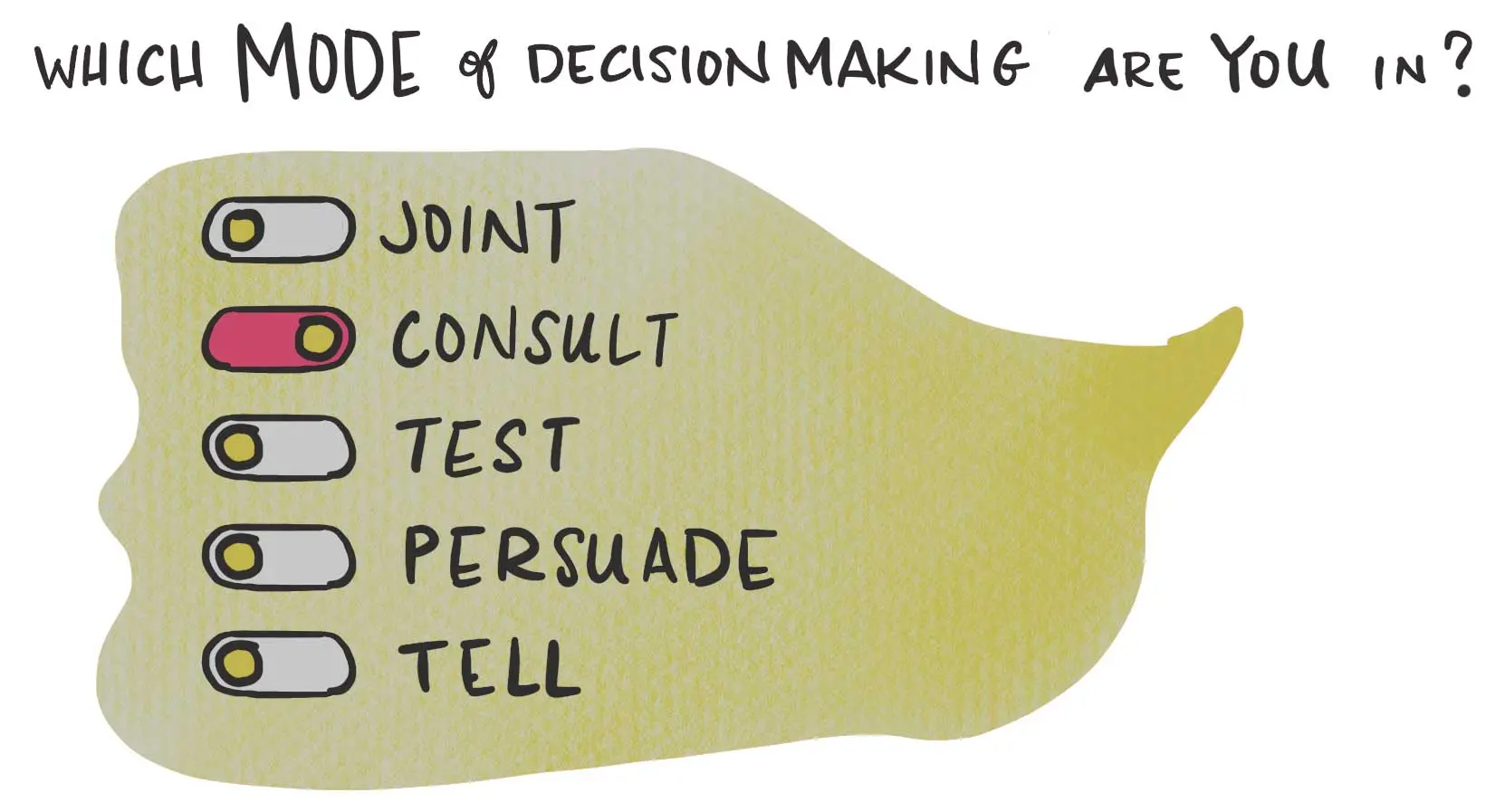To foster greater participation, trust, and transparency on teams, we recommend leaders develop a shared vocabulary about modes of decision-making. Different from a decision-making process (e.g., consensus, majority vote, individual makes the call, etc.), your mode describes the type of input you’re seeking from a person or group. Essentially, it tells people how you’ll engage with suggestions.
The Decision Making Spectrum we use stretches from joint mode (maximum input and collaboration), to consult, test, persuade, and tell mode (when you’re seeking less input). In each mode, you’re aiming to engage or inform participants, especially those closest to the work or most impacted by a decision.

Why mode matters
The shared vocabulary helps participants understand “the ask” and prevents confusion about how decisions will be made. For example, a project manager might use the gradient above to clarify the purpose of a meeting: “We are viewing this as a joint decision. We’ll review the three options today, take questions, and vote using our normal process.” Later in the project, the same manager might meet with the team in a different mode: “To be transparent, I’m in test mode—I’ve thought about XYZ and am leaning toward this path, and I want to see whether you think it’s the right course before I decide. Is there anything else I should consider?”
Being clear about your mode is a key step in fair process decision-making.
For project leaders and managers, getting clear about your mode is a choice point. When staff routinely get asked for input that’s discounted or ignored, they are less likely to feel valued and included, which leads to disengagement—an experience that is all-too-often the norm for staff with marginalized identities or less power. When you’re transparent about your decision mode, it sets expectations and shows you respect people’s time, insight, and energy. Naming your mode is also a good time to reflect on the input you seek, from whom, and how often. Ask yourself:
- Which mode reflects how I will make this decision?
- Who will be impacted by this decision? Are there patterns along lines of race, gender, or other identities I need to be mindful of?
- Where can I build in more authentic collaboration or seek out new perspectives that are frequently left out?
- How often am I showing up in tell or persuade mode? What’s holding me back from seeking more participation in decisions?
Deciding which mode to use
| Joint | Consult | Test | Persuade | Tell | |
|---|---|---|---|---|---|
| When… | The team is the decision-maker and will collaborate to come to agreement; often looks like voting or using a consent/consensus process | The decision-maker(s) are seeking input on a specific decision or option and will consider new ideas or feedback to shape the final outcome; this could look like brainstorming or weighing a few concrete options | Decision-maker(s) have a concept or draft and want to see how it works, lands, or holds up for different audiences | Decision-maker(s) want to build buy-in and have already done work to get here; concerns raised will inform improvements (and, in some rare cases, might change the decision) | The decision is made. Decision-maker(s) are sharing information, including context or rationale, to promote understanding; questions and input will aid implementation |
| Questions you can ask |
|
|
|
|
|
Whether you’re in a group working toward consensus, a director gathering input to inform a decision, or a project leader building buy-in for a solution to a problem, transparency about decision modes combined with openness to feedback can help build the kind of authentic engagement that leads to better outcomes.